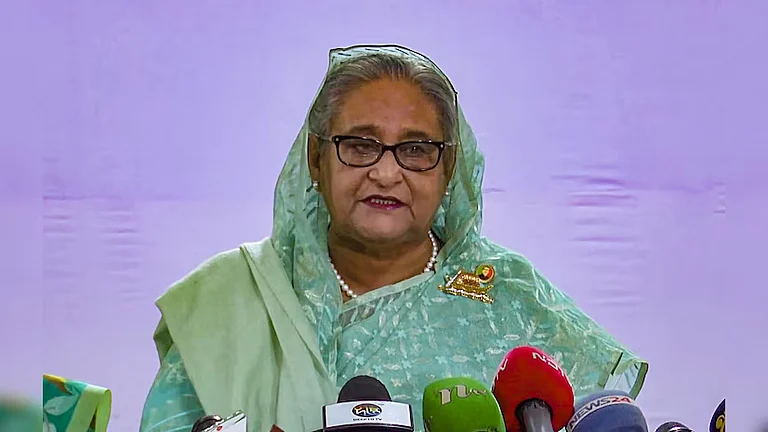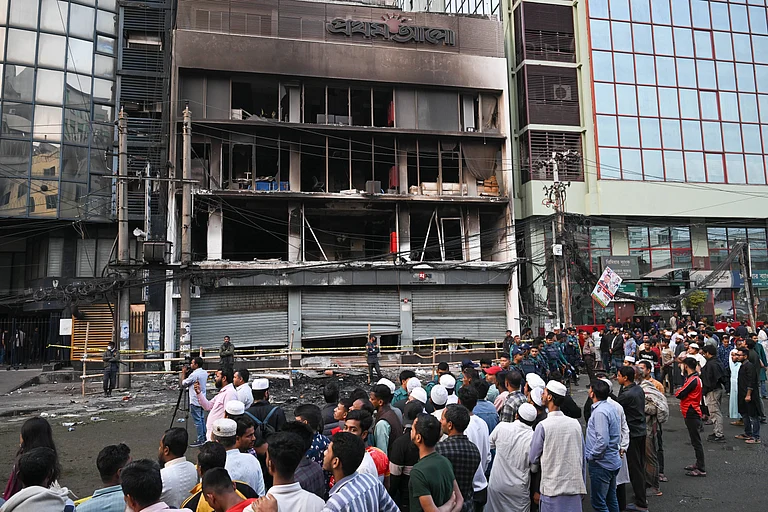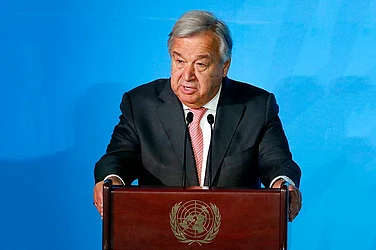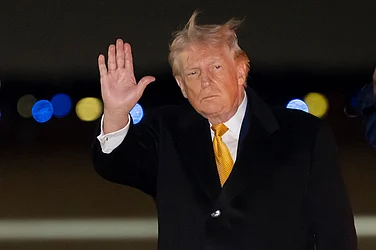I still remember July 18. It was the day I physically joined the protest. Why? The image of Abu Sayeed was engraved in my brain. An unarmed student from Begum Rokeya University in Rangpur, named after the pioneer for women’s liberation in then undivided India, had faced the police bravely as the police fired at him. The first bullet hit him, then the second, yet he stood there until all the air left his lungs. If he can dare to only ask for his rights, then why not me? On July 16, he was killed. On July 18, I stood in front of my campus, BRAC University, and joined thousands of my peers. The police told us that they would support us. And just as we went and sat down on the streets, they charged at us. We retreated but one of my peers stood back up only to get beaten by the police. Seeing that, I could not flee. I went ahead and tried to help him. The police beat us so mercilessly that I limped for the next three days. Sound grenades thrown right in front of me impaired my left ear for the rest of the day. I saw my peers blinded by rubber bullets. And the constant teargas shells left us unsafe even in our own premises as they kept on firing inside. Their bullets forced us to carry the body of my fallen junior wrapped in our flag, making it bloodier than it should have been. But our biggest support that day, I remember, was the local people, consisting mostly of daily labourers and rickshaw pullers, who provided us with food and nourishment free of cost. They came forward to help us and shelter us against our own State.
After 20 traumatic days came August 5, 2024. Former Prime Minister Sheikh Hasina, under whose direction the July massacre took place, resigned from her post and escaped to India. Many of us, including Chief Adviser Muhammad Yunus, have called it the “second independence”. A day some try to question. The long-awaited independence was met by some vandalism and looting, though only for three days, which requires us to analyse through more than just a single lens. Our movement started as the ‘Quota Reform Movement’ against the 56% quota settled for government jobs. But it was forced to turn into civil unrest under the banner of ‘Boishommo Birodhi Chatro Andolon’ (Anti-Discrimination Students Movement).
The reigning regime had, for 16 years, misused and destroyed every instrument of this State. During this period, oligarchy and kleptocracy rose and meted out injustice to people of all classes and religions. The destruction we witnessed was nothing but a build-up of the rage inside those people. The Awami League, the ones who branded themselves as the protectors of minorities, had for their political motivation formed a coalition with the Jamaat-e-Islami (JeM), a former Islamist political party, not once but twice, during 1986 and then again in 1996. The Awami regime ended up hastily banning Jamaat on August 1 due to charges of ‘anti-State’ activities. But in reality, it was done to paint our movement in an extremist light. The reaction by the State during our movement brought out the true image of the Hasina regime as UN APCs were brought in and helicopters fired pointblank. The official death toll from July 16 to August 3 being 266, including 32 children; some killed at their study tables, others while gazing at the sky from their rooftops. On August 4, the highest number of killings in a single day took place in Bangladesh, with the official number crossing a hundred. More than 10,000 mass arrests took place, many of them resulting from paramilitary block raids with sounds of helicopters and gunshots keeping me up all night. Two underaged students were detained by handcuffs and given remand by our courts. Footage of snipers firing at unarmed crowds and uniformed officers shooting at unarmed students has shown us again and again that this regime was never for the people.
Sheikh Mujibur Rahman, known as Bangabandhu, was a leading figure during the Bangladesh liberation struggle, and Sheikh Hasina’s father. On the joyous day of August 5, his murals and statues faced the wrath of the common people. Indian mainstream media saw this as a sign of growing fundamentalism, which is wrong. We have seen how for the last 15 years a figure like Mujib had been iconised by the ruling party only as a means of hiding the corruption that they themselves were breeding. Still, we students, and many other people as well, had respect for Mujib even towards the end. At the end of the movement, our student leaders were seen directly quoting him when the former Prime Minister offered ‘peace talks’, saying “How can we have discussions over dead bodies?” This was something Mujib had also said against the then Pakistani dictator, Yahya Khan. Even the attack on the Bangabandhu National Museum, located in Dhanmondi 32, Dhaka, is not as simple as some would like to believe. As the Chief Adviser had said, “You should ask Hasina why she made him (Mujib) such a bitter thing for the people.”
The attack on the Star Cineplex, a multi-chain cinema hall located in Rajshahi High Tech Park calls for critical analysis. The park had been an initiative of Zunaid Ahmed Palak, the former State minister for Post, ICT and Telecommunications. Palak hails from the Rajshahi area and during the protest, he was the one directly responsible for the ten-day internet blackout. He became one of the faces of the Hasina government during the movement with his public statements having no consistency. One day he stated ‘miscreants’ cut the fiber optics cable, the next day, he stated that the government shut down the line to tackle rumors and the day after, he said the internet apparently shut itself down. During this attack, the Cineplex just happened to bear the brunt and ended up wrongly being branded as the centre of the attack. But the Cineplex is not so innocent either. It is owned by Mahboob Rahman Ruhel, who had become an MP in the last election, the constituency previously under the control of his father, Mosharraf Hossain. Therefore dislike against this entity can be expected. Some attacks have taken place against Hindu houses in some villages, but it would be wrong to see it only from a communal viewpoint. The areas where these attacks took place were pro-Awami areas and all the houses in the area were attacked, not just Hindu homes. Not a single temple had been attacked. Locals, including madrassa students, came forward to stay up all night to guard the temples. A Muslim performed his Fajr prayer in front of a temple, not wanting to leave the place unguarded. According to Niloy Kumar Biswas, a student of Dhaka University, who himself is a Hindu, communal attacks were there but judging them solely through the lens of communality would be wrong. He kept on reiterating that students, who were at the forefront of the movement and the main organisers, condone such attacks and also ensured the safety of all communities.
Attacks on policemen and specifically police stations were witnessed on the night of August 5. Sarjis Alam, one of our leading student coordinators, had pointed out that people were not angry at the policemen, but rather at the misuse of power they perpetuated for 16 years. A few reports of looting and robbery did make the headlines. But after many of them were apprehended by the local people, mainly in Dhaka, they confessed that they had been hired by local Awami leaders to create a sense of anarchy and also to make the most of the lawless period. Screenshots of top Students League leaders, the student wing of the Awami League, have been circulating where it can be seen that they ordered their cadres to attack as many minority establishments as possible to create a binary opposition.
According to Advocate Gobinda Pramanik, the leader of Bangladesh National Hindu Alliance, the people at the forefront of the current minority protection movement are the same ones who stood against the student movement. Communal attacks have unfortunately been a part of our history. But to say that it is the absence of the Hasina regime that is causing them would be wrong. Those who orchestrated the Ramu attack in 2012 are said to have been directly affiliated with the then ruling party, the Awami League. Similarly, a series of communal attacks took place in 2021 in Hajiganj, Bandarban and other places. It was proven that those involved in the attacks are directly associated with the Hasina regime. On August 5, Rahul Ananda’s house was burnt down. He is a well-known musician with followers on both sides of Bengal. The Indian media had blown the incident out of proportion and termed it a communal attack due to his religion. But ultimately it was proven and confirmed by Ananda himself that the attack was not a communal one. Since he lived next to the Bangabandhu National Museum, the fire had spread to his house from there.
For 16 years, Bangladesh has bled and been torn apart. But now, we are turning around. The sudden emergence of ‘Aynaghor’, something once thought to be an urban legend, reveals the oppressive nature of the Hasina regime. Operated by military intelligence, ‘Aynaghor’ was an extrajudicial holding cell where political prisoners were kept without due process. Even after eight years, people are walking out of it alive. Few of the noteworthy names include Brigadier General (dismissed) Abdullahil Aman Azmi, son of the former leader of the Jamaat-e-Islami and war criminal Ghulam Azam, and Supreme Court lawyer Mir Ahmed Bin Quasem, son of executed war criminal Mir Quasem Ali. Post 1971, a period of anarchy did loom before Sheikh Mujib and Tajuddin Ahmed, our first prime minister, took up the duty of establishing law and order. The same hope now arises after the interim government has taken their oath. In the midst of it, students and locals have stepped up to clean this country. Artists in Mymensingh took the initiative and restored the broken monument of Zainul Abedin, a celebrated Bangladeshi painter. Students themselves controlled traffic when the police force was absent from action and no traffic jams occurred. We have also restored the Bangabandhu National Museum at Dhanmondi 32 and also cleaned up our Parliament building.
While performing traffic duty myself, the local people came forward to congratulate and let us know they were with us. I remember a young boy calling out to me from behind and running up to me with a bottle in hand, asking if I needed water. At that moment, I thought of Mugdho, a boy shot dead by the police only because he had distributed water to the protesters.
So many faces flash before my eyes when I think about all the sacrifices made. So many bodies I have seen which the mainstream media tried to hide from me. All these bodies and these faces, all killed simply because of believing in a cause. And some innocent bystanders too. A woman only got up to look out through her window, and a newborn ended up motherless. Riya, a 6-year-old girl, went up to the rooftop to explore the sky with her eyes, and ended up breathing her last. There are so many more like her; children killed for their curiosity. Students killed for their voices. Rappers arrested for their lyrics. We have just been through a war as a nation. Now we need to start to bring to justice all those accountable for these deaths. India should respect its friendship with Bangladesh and extradite the escaped mass murderer to start her long-deserved due process.
Views expressed are personal
(Rishov Aditya is a student at BRAC University, Dhaka, studying Economics and Anthropology)























